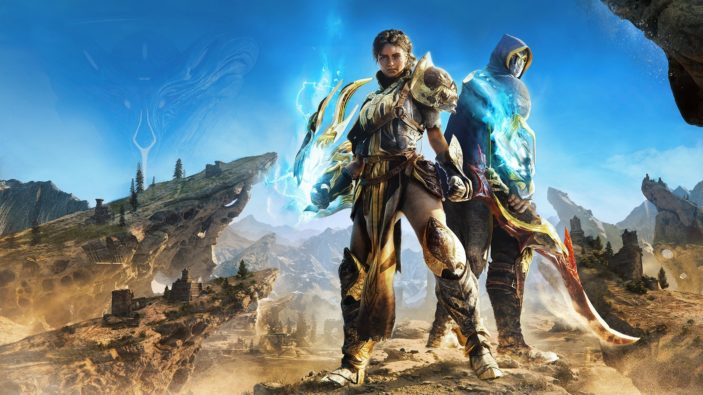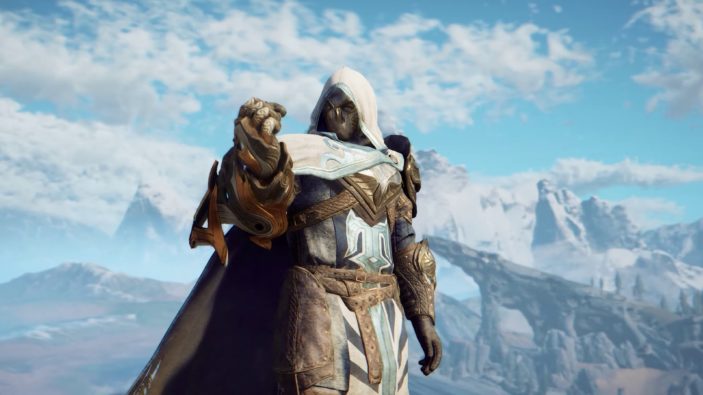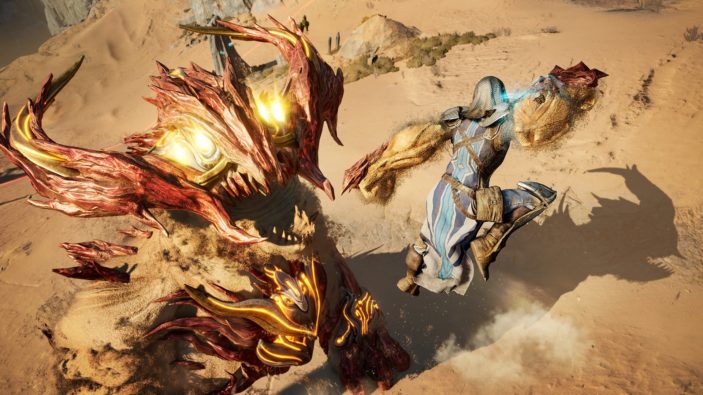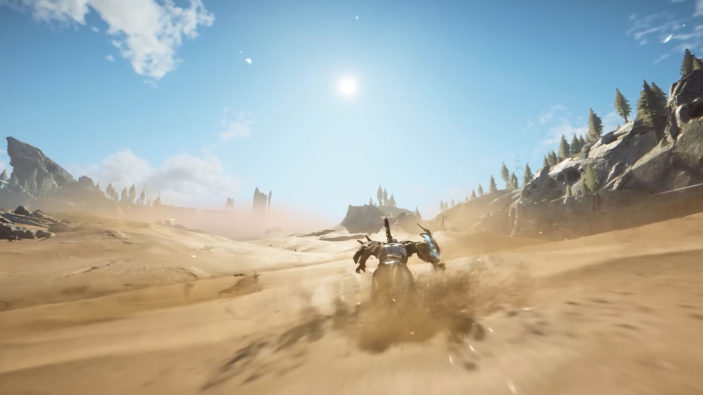
For as little as I had known about Atlas Fallen prior to its release, its final trailers had admittedly hooked me. From the solid third-person combat to sleek traversal and platforming, it seemed there was plenty to look forward to. This proved to be true in many respects, as most of those aspects stood out as the game’s highlights. While the campy story drags things down in terms of writing and voice performances, there is no doubt that Atlas Fallen shines in its fluid combat and dense exploration.
To Catch a Sun God
Players take control of an unnamed, custom-created character who is literally referred to as the Unnamed, as your people regroup and prepare to wage war against a rather tyrannical militia. To make matters worse, the medieval dystopian desert ruins that make up the open world of Atlas, are also ruled by an evil sun god named Thelos, who has also unleashed an army of mythological creatures known as wraiths to roam the land. Talk about being stuck between a rock and a hard place.
Early on in the narrative, our protagonist is sent out into the desert to catch a thief, when they come upon a mysterious gauntlet, which grants them immense ancient powers. Inside this gauntlet also lives Nyaal, yet another sun god, who sticks with you the entire time, as you set out to rid the land of the opposing militia and save Atlas from Thelos. While Nyaal looks incredibly similar to one of the Na’vi from Avatar, his persistent quips and comments throughout the entire narrative wear thin relatively soon.

The story itself isn’t necessarily terrible, but it’s certainly choosing to take the back seat, in turn prioritising the action and exploration. It simply lacks any interesting characters or any personal and emotional development within our protagonist, while relatively bland supporting characters and voice performances have little to no stake in the outcome of the story at hand.
Whipping up a Storm
Atlas Fallen’s combat takes players to its highest peak, delivering some impressive third-person action that feels consistently fluid and responsive. Players can utilise up to two weapons in combat at any given time, each complete with both light and heavy attacks, the latter of which can be done by holding down either of the two attack buttons.
Beyond the general feel of its mechanics, Atlas Fallen’s combat finds its true strength in its Momentum Gauge. Underneath your health bar, sits a blue momentum bar, which is split into three segments. The more damage you deal out, the more this bar fills. As you fill each of the three segments, your weapons grow in size and deal more damage. But at the same time, you also take more damage from enemies. It’s a fantastic balance between risk and reward, that allows you to feel incredibly powerful after just a couple of minutes, only to be struggling to stay alive the next. You can certainly stop attacking in order for this bar to cool down, but I rarely took my foot off the pedal, instead opting for the most devastating approach, dying more than I’d like to admit. With dodge and parry abilities close by to help shake things up, most encounters give you the opportunity to defend yourself, so no death ever really feels cheap.

Both weapons and abilities can be upgraded along the way, with exclusive perks allocated to each of the three segments within your Momentum Gauge, meaning they are only activated once you fill that segment up. It also consistently changes the pace of combat, as you soon learn how to roll these weapons and abilities into one against certain enemies. By completing quests and exploring, you’ll unlock a range of Essence Stones, which grant players various abilities, from health and damage boosts to devastating attacks and defensive buffs. Weapons themselves can be upgraded at Anvils as you discover them, which gives players statistical advantages in combat.
Exploring We Will Go
The open world can be explored on your own terms from the very beginning, while certain areas are usually out of reach until you have unlocked a particular ability. The world of Atlas is divided into four unique biomes of sorts, based around particular environments. The Bastengar fortress and lush Wildlands do a great job of diversifying traversal and exploration, even if the abundance of sand is usually going to creep into the world in some way. The story does a great job of taking you through each of these environments, as you unlock new traversal abilities to head back and explore those previously inaccessible areas.
While players can actually take on board a number of main and side-quests to complete in any order, many of the rewards gained from completing missions will be given to you in the same order, meaning that no matter which way you complete these missions, those rewards will be the same. It’s not necessarily detrimental to progression in any way, as there are so many upgrades and perks to build upon and choose from. That being said, I do recommend completing mainline quests regularly, as they unlock abilities like double and triple dash, that are necessary for exploration in most areas. Simply exploring these areas is still a bunch of fun, as you’ll glide across the sand from point to point, while navigating multiple hidden areas and surprise enemy encounters.

Along the way, players can buddy up with another friend online for drop-in, drop-out cooperative play, which is undeniably a bunch of fun. It does little to alter or shake up the story itself, but the sheer joy of encountering enemies in combat is so consistently satisfying, as you each bring your own builds and abilities to battle. Certain enemies and bosses have a number of vulnerable body parts which can be individually targeted and damaged, making it a key to coordinate your attacks which can take larger, hulking enemies down in a matter of seconds.
Finally, while Atlas Fallen looks fine visually, its impressive draw distances do the larger, diverse open world justice. Standing in the middle of a desert and looking out into the distance as green hills surround the horizon is a wonder to behold, while the ability to actually go there makes it that much sweeter. General performance is adequate, as the game runs at either 4K/30fps or 1440p/60fps, but I found that either option still presented a number of frame rate drops, particularly during more chaotic combat encounters. If I can recommend one of the two options, stick with the latter.
Final Thoughts
Overall, Atlas Fallen is worth playing for a bunch of reasons. From satisfying combat and cooperative play to varied exploration and a range of upgradeable abilities and ways to play, there’s something here for most players. While the campy story, wonky voice performances and occasional frame rate drops wear the experience down at times, there’s no doubt that its strengths are consistently in found in its gameplay. And at the end of the day, if you just like sand, Atlas Fallen still might be worth checking out.
THREE AND A HALF STARS (OUT OF FIVE)
Highlights: Fun and addictive combat; Cool traversal; Detailed open-world
Lowlights: Campy story
Developer: Deck13
Publisher: Focus Entertainment
Platforms: PlayStation 5, Xbox Series X/S, Windows PC
Available: Now
Review conducted on PlayStation 5 with a pre-release code provided by the publisher.
